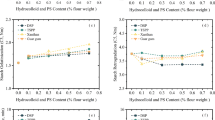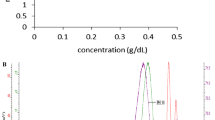Abstract
Fresh persimmon puree showed a rheological behavior corresponding to a weak gel, where storage modulus (G′) prevailed over loss modulus (G″). In a temperature sweep test (from 25–80–25 °C), G′ values increased at temperatures above 60 °C and continued increasing during the subsequent cooling step showing a wide scattering. These changes indicated a gelation phenomena that resulted in a more rigid and irregular gel structure. The gelation was lower in the acidified puree (pH 4.4) than in the puree at its natural pH (5.9). The addition of ethylenediaminetetraacetate sodium avoided the increase of G′ during the heating and reduced the G′ increase in the cooling step. Thus, gelation in persimmon puree occurred by a heat-set gelation influenced by pH, and also by cold-set gelation depending on an ionotropic mechanism. The incubation of persimmon puree with Viscozyme L (1 g/L, 25 °C, 30 min) allowed to obtain a more fluid product able to tolerate a thermal processing at 85 °C without gelation. During the incubation with Viscozyme L, the pH of the persimmon puree decreased monotonically as a consequence of its pectinmetylesterase activity, and the continuous measurement of pH could be used to monitor this process.








Similar content being viewed by others
References
Achiwa, T., Hibasami, H., Katsuzaki, H., Imai, K., & Komiya, T. (1997). Inhibitory effects of persimmon (Diospyros kaki) extract and related polyphenol compounds on growth of human lymphoid leukemia cells. Bioscience, Biotechnology, and Biochemistry, 61, 1099–1101.
Anon (1991). Product sheet of Viscozyme L. Bagsvaerd: Novo Nordisk A/S, Enzymes Process Division.
Burey, P., Bhandari, B. R., Howes, T., & Gidley, M. J. (2008). Hydrocolloid gel particles: formation, characterization and application. Critical Reviews in Food Science and Nutrition, 48, 361–377.
Carbonell, J. V., Contreras, P., Carbonell, L., & Navarro, J. L. (2006). Pectin methylesterase activity in juices from mandarins, oranges and hybrids. European Food Research and Technology, 222, 83–87.
Fraeye, I., Duvetter, T., Doungla, E., van Loey, A., & Hendrickx, M. (2010). Fine-tuning the properties of pectin–calcium gels by control of pectin fine structure, gel composition and environmental conditions. Trends in Food Science & Technology, 21, 219–228.
Galanakis, C. M., Tornberg, E., & Gekas, V. (2010a). A study of the recovery of the dietary fibres from olive mill wastewater and the gelling ability of the soluble fibre fraction. LWT- Food Science and Technology, 43, 1009–1017.
Galanakis, C. M., Tornberg, E., & Gekas, V. (2010b). The effect of heat processing on the functional properties of pectin contained in olive mill wastewater. LWT- Food Science and Technology, 43, 1001–1008.
Gorinstein, S., Zemser, M., Weisz, M., Halevy, S., Deutsch, J., Tilis, K., et al. (1994). Fluorometric analysis of phenolics in persimmons. Bioscience, Biotechnology, and Biochemistry, 58, 1087–1092.
Gorinstein, S., Bartnikowska, E., Kulasek, G., Zemser, M., & Trakhtenberg, S. (1998). Dietary persimmon improves lipid metabolism in rats fed diets containing cholesterol. The Journal of Nutrition, 128, 2023–2027.
Grosso, C. R. F., & Rao, M. A. (1998). Dynamic rheology of structure development in low-methoxyl pectin + Ca2+ sugar gels. Food Hydrocolloids, 12, 357–363.
Matsuo, T., & Itoo, S. (1978). The chemical structure of kaki–tannin from immature fruit of the persimmon (Diospyros kaki, L.). Agricultural and Biological Chemistry, 42, 1637–1643.
Matsuo, T., & Itoo, S. (1982). A model experiment for de-astringency of persimmon fruit with high carbon dioxide treatment. In vitro gelling of kaki tannin by reacting with acetaldehyde. Agricultural and Biological Chemistry, 46, 683–688.
Oakenfull, D. G. (1991). The chemistry of high-methoxyl pectin gelation. In R. H. Walter (Ed.), The chemistry and technology of pectin. New York: Academic.
Padival, R. A., Ranganna, S., & Manjrekar, S. P. (1979). Mechanism of gel formation by low methoxyl pectins. International Journal of Food Science and Technology, 14, 277–287.
Salvador, A., Arnal, L., Besada, C., Larrea, V., Hernando, I., & Pérez-Munuera, I. (2008). Reduced effectiveness of the treatment for removing astringency in persimmon fruit when stored at 15 °C: physiological and microstructural study. Postharvest Biology and Technology, 49, 340–347.
Taira, S., Ono, M., & Matsumoto, N. (1997). Reduction of persimmon astringency by complex formation between pectin and tannins. Postharvest Biology and Technology, 12, 265–271.
Thakur, B. R., Sing, R. K., & Handa, A. K. (1997). Chemistry and uses of pectin—a review. Critical Reviews in Food Science and Nutrition, 37, 7–73.
U.S. Department of Agriculture, Agricultural Research Service. 2009. USDA National Nutrient Database for Standard Reference, Release 22. Nutrient Data Laboratory Home Page, http://www.ars.usda.gov/nutrientdata
Acknowledgments
This research was supported by the Spanish Government (Ministerio de Ciencia e Innovación–MICINN, project AGL2009-11805ALI). The authors also thank Fondo Social Europeo for Gurrea’s contract I3P and MICINN for Tarrega’s contract (Juan de la Cierva Program).
Author information
Authors and Affiliations
Corresponding author
Additional information
Sources of support: Spanish Government (Ministerio de Ciencia e Innovación, project AGL2009-11805ALI and Tarrega's contract, Juan de la Cierva Program). Fondo Social Europeo (Gurrea’s contract in the program I3P).
Rights and permissions
About this article
Cite this article
Tárrega, A., del Carmen Gurrea, M., Navarro, J.L. et al. Gelation of Persimmon Puree and Its Prevention by Enzymatic Treatment. Food Bioprocess Technol 6, 2399–2405 (2013). https://doi.org/10.1007/s11947-012-0890-x
Received:
Accepted:
Published:
Issue Date:
DOI: https://doi.org/10.1007/s11947-012-0890-x




